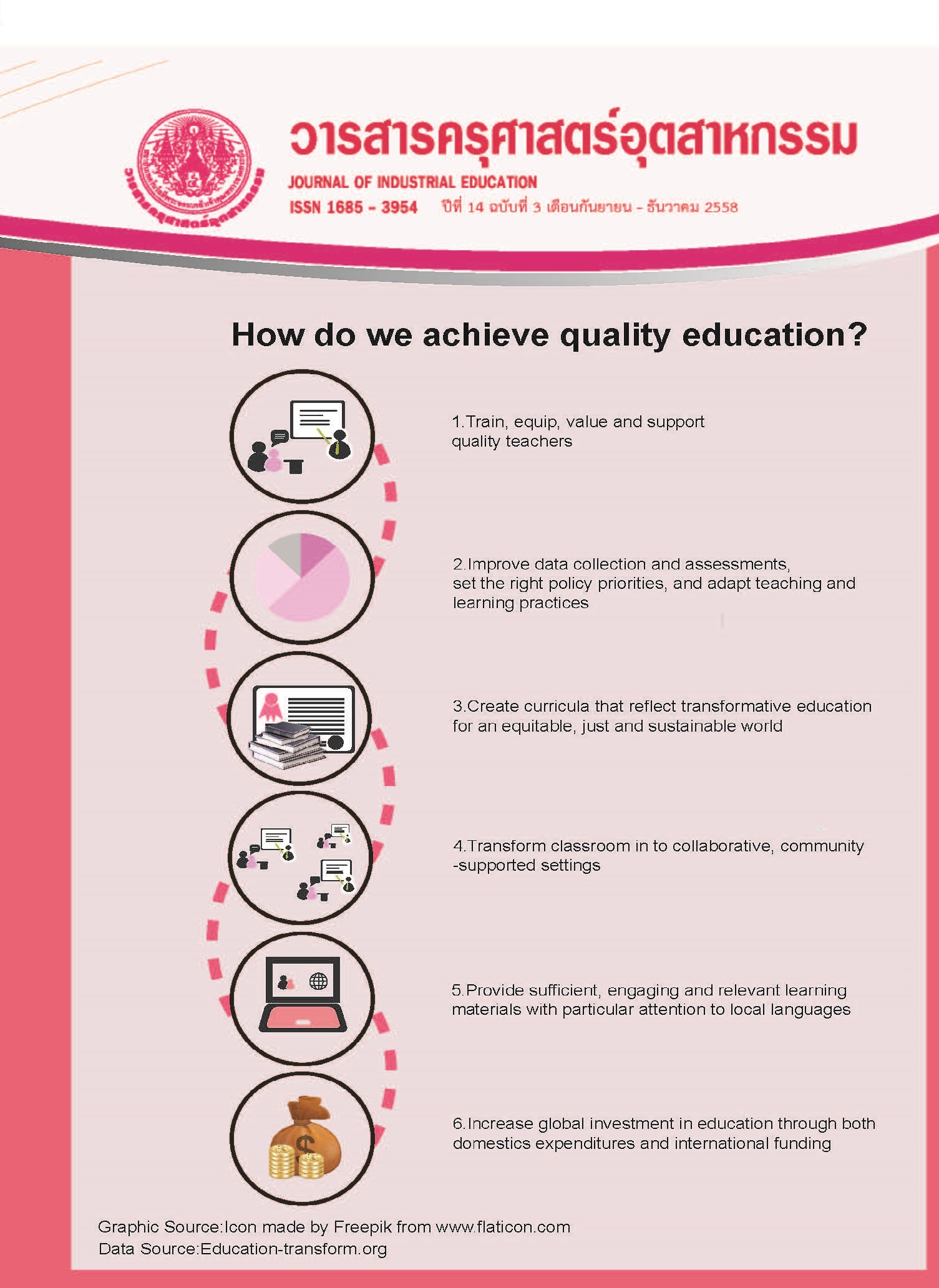การพัฒนาบทเรียนบนเครือข่ายอินเทอร์เน็ตโดยใช้กระบวนการสอนแบบซินเนคติคส์ เรื่อง คอมพิวเตอร์กราฟิกสร้างสรรค์ ชั้นมัธยมศึกษาปีที่ 6
Main Article Content
บทคัดย่อ
การวิจัยนี้มีวัตถุประสงค์เพื่อพัฒนาบทเรียนบนเครือข่ายอินเทอร์เน็ตโดยใช้กระบวนการสอนแบบซินเนคติคส์ เรื่อง คอมพิวเตอร์กราฟิกสร้างสรรค์ ชั้นมัธยมศึกษาปีที่ 6 ให้มีคุณภาพและประสิทธิภาพ และเปรียบเทียบผลสัมฤทธิ์ทางการเรียนก่อนกับหลังเรียน ด้วยบทเรียนบนเครือข่ายอินเทอร์เน็ตโดยใช้กระบวนการสอนแบบซินเนคติคส์ เรื่อง คอมพิวเตอร์กราฟิกสร้างสรรค์ ชั้นมัธยมศึกษาปีที่ 6 กลุ่มตัวอย่างที่ใช้ในการวิจัย คือ นักเรียนชั้นมัธยมศึกษาปีที่ 6 โรงเรียนชำนาญสามัคคีวิทยา ภาคเรียนที่ 2 ปีการศึกษา 2557 โดยวิธีการสุ่มตัวอย่างแบบกลุ่ม จำนวน 40 คน เครื่องมือที่ใช้ในการวิจัยครั้งนี้ คือ บทเรียนบนเครือข่ายอินเทอร์เน็ตโดยใช้กระบวนการสอนแบบซินเนคติคส์ เรื่อง คอมพิวเตอร์กราฟิกสร้างสรรค์ ชั้นมัธยมศึกษาปีที่ 6 แบบประเมินคุณภาพบทเรียนและแบบทดสอบวัดผลสัมฤทธิ์ทางการเรียน ซึ่งมีค่าความยากง่ายอยู่ระหว่าง 0.50-0.77 ค่าอำนาจจำแนกอยู่ระหว่าง 0.20-0.70 และค่าความเชื่อมั่นเท่ากับ 0.84 สถิติที่ใช้ในการวิเคราะห์ข้อมูล คือ ค่าเฉลี่ย ( ) ส่วนเบี่ยงเบนมาตรฐาน (S) และ t-test แบบ Dependent Samples
ผลการวิจัยพบว่า บทเรียนบนเครือข่ายอินเทอร์เน็ตโดยใช้กระบวนการสอนแบบซินเนคติคส์ เรื่อง คอมพิวเตอร์กราฟิกสร้างสรรค์ ของนักเรียนชั้นมัธยมศึกษาปีที่ 6 มีคุณภาพด้านเนื้อหาอยู่ในระดับดีมาก ( =4.53, S = 0.07) และคุณภาพด้านเทคนิคการผลิตสื่ออยู่ในระดับดีมาก (
= 4.51, S = 0.40) และประสิทธิภาพของบทเรียนบนเครือข่ายอินเทอร์เน็ต E1/E2 เท่ากับ 81.59/81.27 เป็นไปตามเกณฑ์ที่กำหนด 80/80 และผลสัมฤทธิ์ทางการเรียนของผู้เรียนหลังเรียนสูงกว่าก่อนเรียนอย่างมีนัยสำคัญที่ระดับ 0.05
Article Details
"ข้อคิดเห็น เนื้อหา รวมทั้งการใช้ภาษาในบทความถือเป็นความรับผิดชอบของผู้เขียน"
References
[2] สำนักงานพัฒนาธุรกรรมทางอิเล็กทรอนิกส์ (องค์การมหาชน). 2556. รายงานผลการสำรวจพฤติกรรมการใช้อินเทอร์เน็ตในประเทศไทยปี 2556. กระทรวงเทคโนโลยีสารสนเทศและการสื่อสาร.
[3] อารี พันธ์มณี. 2537. ความคิดสร้างสรรค์. กรุงเทพฯ: ต้นอ้อ.
[4] มนต์ชัย เทียนทอง. 2545. การออกแบบและพัฒนาคอร์สแวร์สำหรับบทเรียนคอมพิวเตอร์ช่วยสอน. กรุงเทพฯ: ภาควิชาคอมพิวเตอร์ศึกษาคณะครุศาสตร์อุตสาหกรรม สถาบันเทคโนโลยีพระจอมเกล้าพระนครเหนือ.
[5] Gordon. W J.J. 1961. Synectics: The Development of creative Capacity. New York: Harper & Row.
[6] ไพโรจน์ ตีรณธนากุล. 2546. การออกแบบและการผลิตบทเรียนคอมพิวเตอร์การสอนสำหรับe-learning. กรุงเทพฯ: โรงพิมพ์มพ์ดี จำกัด.
[7] ชัยยงค์ พรหมวงศ์. 2542. ระบบสื่อการสอน.กรุงเทพฯ: โรงพิมพ์จุฬาลงกรณ์มหาวิทยาลัย.
[8] Bloom, B.S. 1976. Human Characteristics and School Learning.New York: McGraw – Hill Book Company.
[9] พรเทพ เมืองแมน. 2544. การออกแบบและพัฒนา CAI Multimedia ด้วย Authorware. กรุงเทพฯ: ซีเอ็ด ยูเคชั่น.
[10] วิรัตน์ คุ้มคำ. 2534. การพัฒนาความคิดสร้างสรรค์ของนักเรียนชั้นประถมศึกษาปีที่ 5 ที่เรียนวิชาศิลปศึกษาด้วยวิธีการระดมสมอง. วิทยานิพนธ์ปริญญาครุศาสตรมหาบัณฑิต สาขาวิชาศิลปศึกษา บัณฑิตวิทยาลัย จุฬาลงกรณ์มหาวิทยาลัย.
[11] กรมวิชาการ. 2556. หลักสูตรประถมศึกษา พุทธศักราช 2521 (ฉบับปรับปรุง พ.ศ. 2533) พิมพ์ครั้งที่ 2. กรุงเทพฯ: โรงพิมพ์ การศาสนา.
[12] อภันตรี วังสงค์ และคณะ. 2553. บทเรียนคอมพิวเตอร์ช่วยสอนเพื่อการทบทวนเรื่องการสร้างแอนิเมชั่นแบบโมชั่นทวิน. วารสารครุศาสตร์อุตสาหกรรม, 9(2) น.165-173.
[13] ธรรมนูญ เกษมศรีวิทยา และคณะ. 2557.บทเรียนอิเล็กทรอนิกส์เพื่อการทบทวนเรื่องการเขียนโปรแกรมภาษาเบสิก สำหรับไมโครคอนโทรเลอร์ พีไอซี. วารสารครุศาสตร์อุตสาหกรรม, 13(2), น. 153-158.

